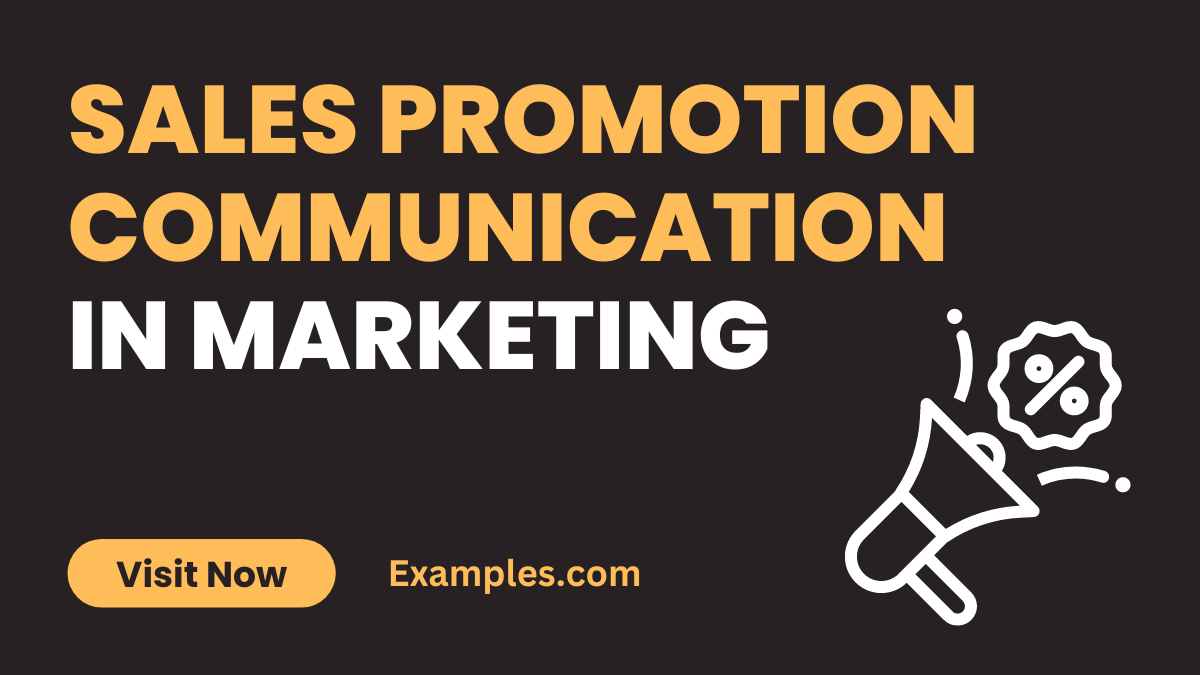19+ Sales Promotion Communication in Marketing Examples
In the dynamic world of marketing communication, understanding Sales Promotion Communication is crucial for businesses aiming to enhance their market presence. This guide delves into the essence of Sales Promotion Communication, offering practical examples and strategies to effectively communicate promotions. It serves as an invaluable resource for marketing professionals, providing insights on how to captivate and engage audiences, thereby maximizing the impact of marketing campaigns.
What is Sales Promotion Communication in Marketing
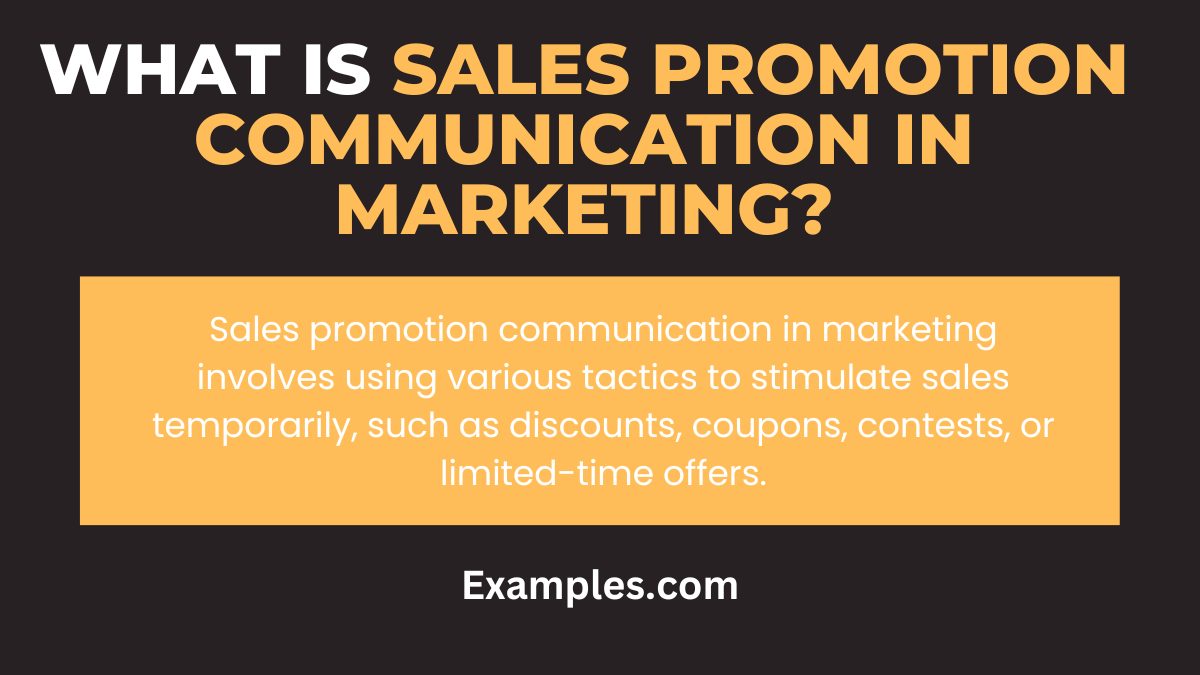
Sales Promotion Communication in Marketing refers to the strategic use of various communication tools and channels to inform, persuade, and remind customers about promotional activities. It’s an integral part of the marketing communication process, designed to boost short-term consumer interest and influence purchase decisions. This method effectively combines elements like discounts, contests, and special offers with communication channels to create compelling marketing messages.
What is the Best Example of Sales Promotion Communication in Marketing?
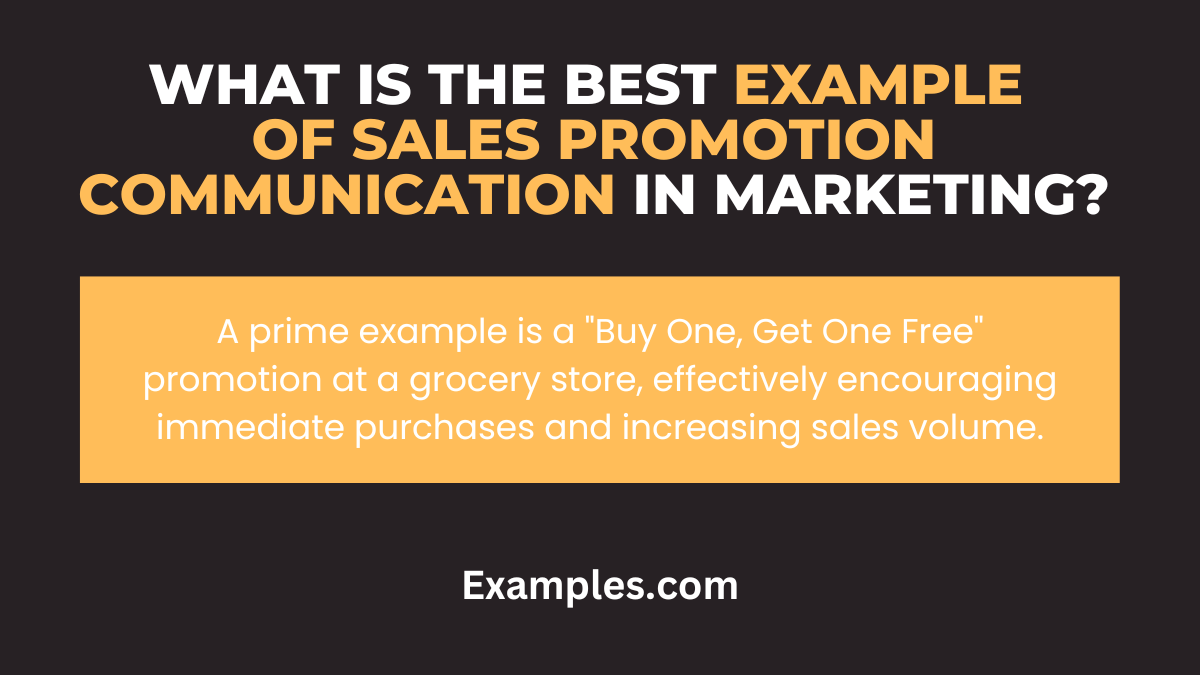
A quintessential example of Sales Promotion Communication is a time-limited discount offer communicated via social media and email marketing. This approach not only reaches a broad audience quickly but also creates a sense of urgency. For instance, a clothing brand launching a “30% off for 48 hours” campaign through targeted emails and social media posts. This strategy effectively combines Sales Promotion Communication with Content Marketing Communication, engaging customers and driving immediate action.
Examples of Sales Promotion Communication in Marketing
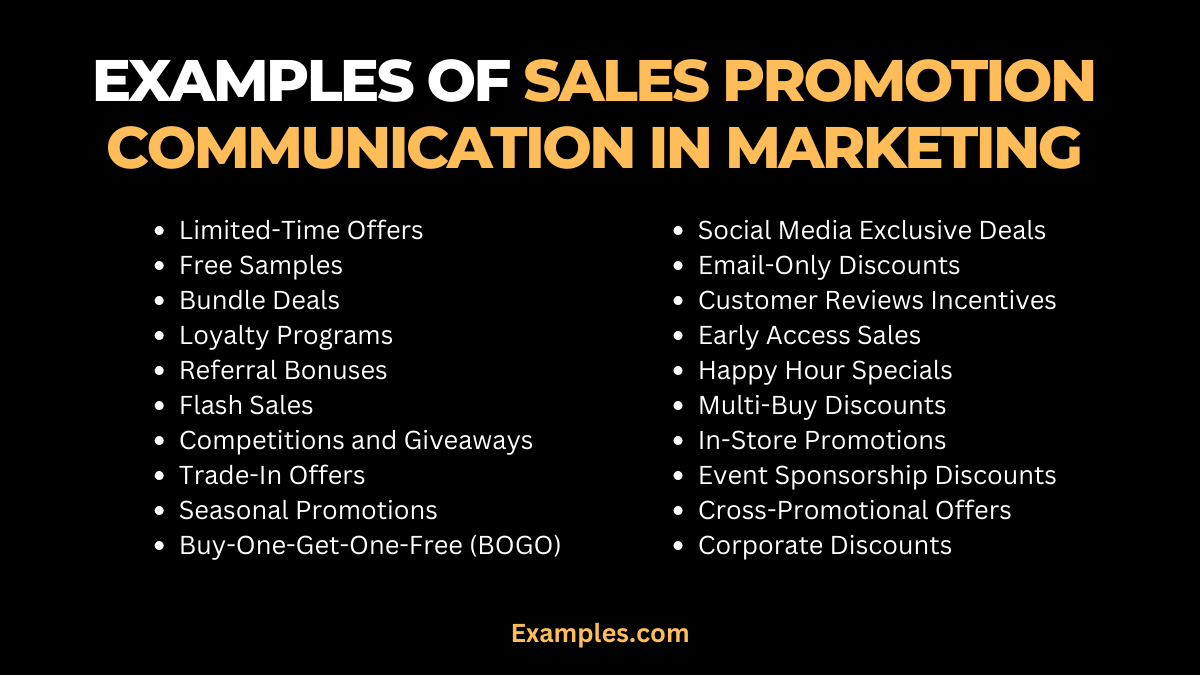
Discover how effective sales promotion communication enhances marketing strategies. This comprehensive guide delves into the art of conveying promotional messages, highlighting 20 distinct skills in the realm of sales promotion. Each example showcases practical methods and phrases to effectively communicate with consumers, elevating Marketing Communication Strategies and Sales Promotion Communication in Marketing. Ideal for professionals aiming to refine their promotional tactics, this guide is a valuable resource for achieving marketing excellence.
- Limited-Time Offers: Create urgency by announcing time-sensitive deals.
Example: “Hurry! This exclusive 50% discount on our best-selling products ends in 24 hours.” - Free Samples: Introduce new products by offering free samples.
Example: “Experience the difference for yourself! Get your free sample of our new skincare line today.” - Bundle Deals: Encourage larger purchases with bundled products at a reduced price.
Example: “Buy a laptop and get a free carrying case and mouse – a perfect combo for your needs.” - Loyalty Programs: Reward repeat customers to foster loyalty.
Example: “Join our loyalty program and earn points with every purchase to redeem exciting rewards.” - Referral Bonuses: Leverage word-of-mouth through incentives for referrals.
Example: “Refer a friend and both of you will receive a 10% discount on your next purchase.” - Flash Sales: Attract immediate attention with short-term deep discounts.
Example: “Flash Sale! Get up to 70% off on selected items until midnight only.” - Competitions and Giveaways: Engage customers through contests and prizes.
Example: “Enter our photo contest and stand a chance to win a year’s supply of our products.” - Trade-In Offers: Encourage upgrades by providing discounts on trade-ins.
Example: “Trade in your old model and get a 25% discount on the latest version.” - Seasonal Promotions: Tailor offers to seasonal events and holidays.
Example: “Celebrate this Christmas with exclusive deals on our festive collection.” - Buy-One-Get-One-Free (BOGO): Increase sales volume with BOGO offers.
Example: “Buy one pizza and get another absolutely free! Perfect for sharing.” - Social Media Exclusive Deals: Utilize social platforms for unique offers.
Example: “Follow us on Instagram and access our followers-only 15% discount code.” - Email-Only Discounts: Encourage email sign-ups with special offers.
Example: “Subscribe to our newsletter and receive an exclusive 20% off coupon.” - Customer Reviews Incentives: Motivate customers to leave reviews for rewards.
Example: “Leave a review and get a 10% coupon for your next purchase.” - Early Access Sales: Offer loyal customers first access to new products.
Example: “VIP customers get early access to our new collection – shop before anyone else!” - Happy Hour Specials: Apply time-specific discounts to boost slow periods.
Example: “Enjoy our happy hour deals with 50% off on all appetizers from 3-5 PM.” - Multi-Buy Discounts: Promote bulk purchases through volume discounts.
Example: “Buy 3 t-shirts and get the 4th one for free! Stock up on your favorites.” - In-Store Promotions: Attract foot traffic with exclusive in-store deals.
Example: “Visit our store this weekend for a special 20% discount on all items.” - Event Sponsorship Discounts: Leverage event exposure for promotions.
Example: “Attendees of the Summer Fest get a 30% discount at our booth.” - Cross-Promotional Offers: Partner with other brands for mutual benefits.
Example: “Buy our coffee and get a coupon for 10% off at the neighboring bookstore.” - Corporate Discounts: Offer special pricing to employees of partner companies.
Example: “Employees of our partner firms enjoy an exclusive 15% discount on all services.”
Importance of Sales Promotion Communication in Marketing
- Boosting Short-Term Sales: Sales promotion communication is crucial for stimulating immediate consumer interest and driving short-term sales increases. It effectively creates urgency, encouraging customers to make prompt purchases.
- Brand Awareness and Visibility: These promotions enhance brand visibility. By capturing consumer attention, they contribute to a stronger market presence.
- Customer Engagement and Loyalty: Engaging customers through sales promotions strengthens customer loyalty. These activities often include rewards that encourage repeat purchases.
- Introduction of New Products: When launching new products, sales promotions help in creating initial consumer interest and trial purchases.
- Competitive Edge: In a crowded market, effective sales promotion communication can distinguish a brand from its competitors, attracting more customers.
- Market Research and Feedback: Promotions can serve as a tool for gathering valuable market feedback, aiding in product development and marketing strategies.
- Increased Distribution: Retailers are more inclined to stock products with active promotional strategies, thus expanding market reach and distribution channels.
Types of Sales Promotion Communication in Marketing
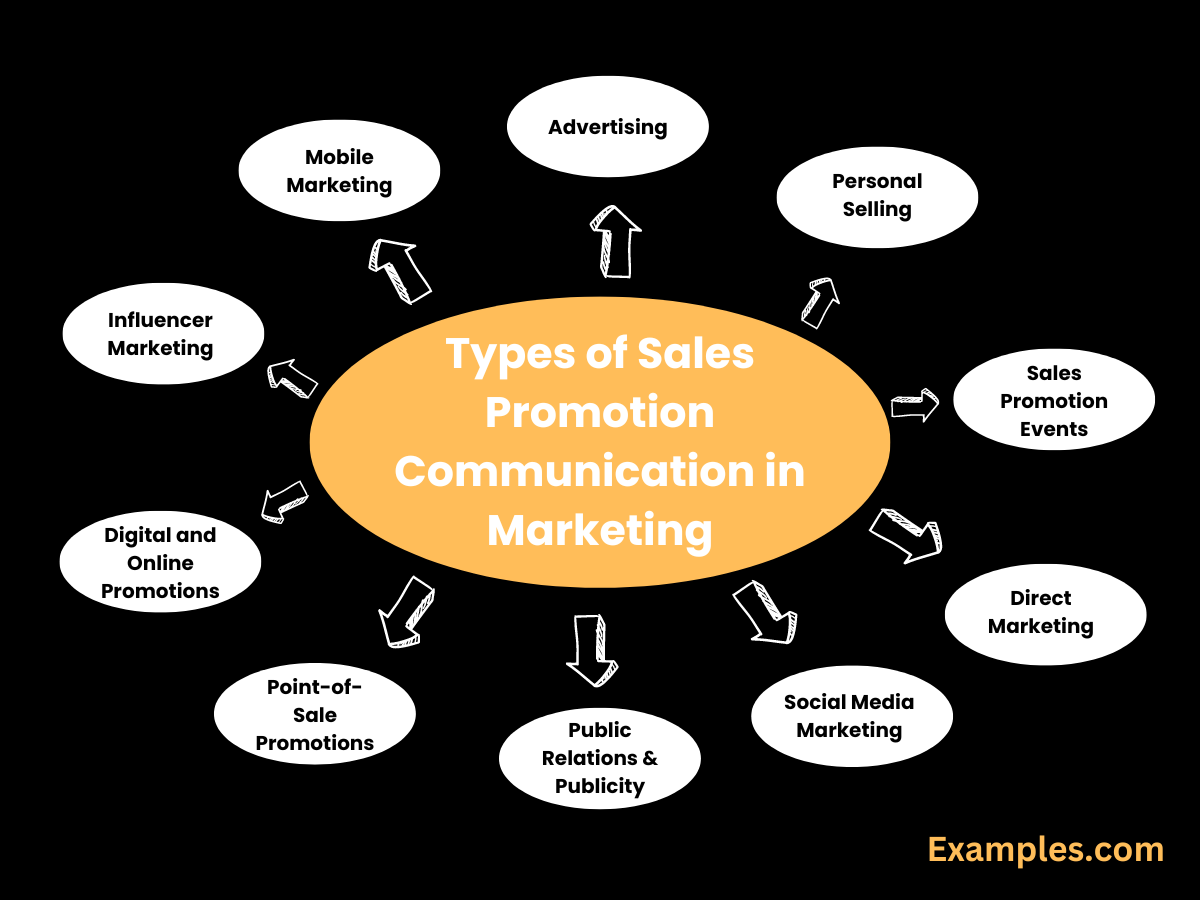
Sales promotion communication in marketing plays a pivotal role in attracting customers and boosting sales. Various techniques are employed to communicate promotional offers effectively. Here are some key types:
1. Advertising
Advertising is a widespread form of sales promotion communication, utilizing various media channels like TV, radio, print, and digital platforms. It’s designed to reach a large audience, informing them about promotional offers, discounts, or new product launches.
2. Personal Selling
Personal selling involves direct interaction between a salesperson and a customer. This personalized approach allows for tailored communication, addressing specific needs and preferences of the customer, often leading to immediate sales.
3. Sales Promotion Events
Organizing events like trade shows, exhibitions, or product demonstrations is a dynamic way of promoting sales. These events provide an interactive platform for direct communication with potential customers and showcasing products or services.
4. Direct Marketing
Direct marketing involves sending promotional materials directly to potential customers through mail, email, or messaging. This targeted approach ensures that promotional content reaches those most likely to be interested in the product or service.
5. Social Media Marketing
Utilizing social media platforms for sales promotion allows businesses to engage with a broad and diverse audience. Through posts, stories, and ads, companies can effectively communicate their promotional offers, reaching customers where they spend a significant amount of time.
6. Public Relations and Publicity
Public relations activities, such as press releases or public statements, help in creating a favorable image of the product or service. Publicity, often a result of these activities, provides free promotion through media coverage.
7. Point-of-Sale Promotions
Point-of-sale promotions involve communicating offers at the place where the purchase is made. This can include in-store displays, posters, and digital signage that catch the customer’s attention during the buying process.
8. Digital and Online Promotions
Online promotions, including email marketing, online ads, and website promotions, are crucial in today’s digital age. They provide a cost-effective way to reach a vast audience with personalized promotional messages.
9. Influencer Marketing
Partnering with influencers to promote products or services leverages their follower base for promotional communication. This approach can be highly effective due to the trust and credibility influencers have with their audience.
10. Mobile Marketing
Mobile marketing uses SMS, MMS, and mobile apps to communicate promotional offers. Its immediacy and personal nature make it a powerful tool for reaching customers directly on their mobile devices.
What is the Sales Promotion Communication Process in Marketing
- Objective Setting: Defining clear objectives for the promotion, such as increasing sales, market penetration, or customer acquisition.
- Target Audience Identification: Determining the target consumer segment for the promotion to ensure effective communication.
- Message Development: Crafting a compelling promotional message that resonates with the target audience.
- Selection of Promotional Tools: Choosing the appropriate types of sales promotions (discounts, contests, etc.) to meet the campaign objectives.
- Communication Channel Selection: Utilizing the most effective Marketing Communication Channels to reach the target audience.
- Implementation and Execution: Launching the promotion and ensuring all elements are executed as planned.
- Evaluation and Feedback Analysis: Assessing the success of the promotion against objectives and analyzing feedback for future improvements.
What is the Role of Sales Promotion Communication in Marketing?
- Driving Purchase Decisions: Sales promotions influence consumer purchase decisions, often converting interest into actual sales.
- Enhancing Brand Image: Skillfully designed promotions can improve brand perception and positioning in the market.
- Facilitating Product Introduction: Promotions ease the introduction of new products into the market by generating interest and trials.
- Market Penetration and Expansion: Helping brands penetrate existing markets more deeply and enter new markets.
- Supporting Other Marketing Efforts: Sales promotions work in tandem with other Marketing Communication Strategies to create a comprehensive marketing approach.
- Creating Competitive Advantage: Unique and attractive promotions can provide a competitive edge in a saturated market.
- Cultivating Customer Relationships: Promotions encourage customer engagement, leading to stronger customer relationships and loyalty.
Mastering sales promotion communication in marketing is key to captivating audiences and driving sales. From traditional advertising to innovative social media tactics, each method offers unique advantages for reaching target demographics. Understanding and skillfully integrating these diverse communication strategies can significantly enhance marketing campaigns, leading to greater brand recognition and business success.



